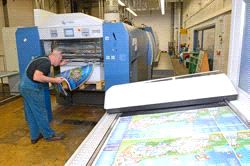Offset Printing
20,000sph KBA Rapida 106 in Lahr

Thursday 31. July 2014 - Druckhaus Kaufmann banks on high added value with catalogues and magazines
A new, high-performance sheetfed offset press from KBA has been in operation at Druckhaus Kaufmann in Lahr, Germany, since the end of January. The KBA Rapida 106 equipped with five inking units, a coater and delivery extension prints at speeds of up to 20,000sph.
However, the printing firm which was founded in 1816 does not primarily print in sheetfed offset, but will instead use this new press to supplement its web offset business with a focus on producing catalogues and magazines. Kaufmann believes in creating a high level of added value within the company. Along with high quality web printing this also includes post-press with strengths lying in adhesive binding, the production of supplementary products for catalogues and magazines as well as a raft of specialities, such as printing pattern sheets as supplements or stitched inserts in fashion magazines.
Rapida replaces two older presses
Covers make up 80 per cent of the jobs produced on the KBA Rapida 106. The other 20 per cent comprises sheetfed jobs in connection with web printing. As the number of sheetfed copies is linked to the web products, less importance was placed on short makeready when equipping the Rapida 106. Only one to two job changes are necessary per shift with an average print run of 50,000. When deciding to invest the company instead focused on high production output, a solid coater and a pull lay which does not mark the sheets. The Rapida 106 thus won points with its unique DriveTronic SIS no-sidelay infeed. This highly automated press features automatic plate changers, CleanTronic washing systems and an ErgoTronic ICR automatic register measuring system. Thanks to its enormous production output of up to 20,000sph the press was able to replace two older sheetfed offset presses. After one single-shift week and seven three-shift weeks it has clocked up an outstanding 7,25m sheets.
‘s two previous presses have already been disassembled (1)Managing partner Markus Kaufmann says: “I was surprised just how smoothly everything went during the press installation and that there was no need for any subsequent work”. Karl-Heinz Becker authorised officer and technical director adds, “Delivery, construction and inauguration all happened in just one and a half weeks, and we accepted the press immediately afterwards.”
If circulations hadn’t been dwindling in recent years, Markus Kaufmann would have opted for a large-format press. A B3 press is, however, satisfactory and production at his company is fully utilised. Just as circulations are falling, the number and diversity of highly specialised titles is increasing. The flexible Rapida meets these requirements perfectly. KBA made the company the best offer in terms of quality, value for money and financing. The Rapida also ranked highly with the printers and shift managers who were involved in the decision-making process, even though they had previously worked with presses from a different manufacturer.
Finishing is becoming increasingly more important
The visual demands of the individual titles significantly increase with diversification. All titles have to stand out and entice consumers to buy, whether it be fashion, women’s and specialist magazines or catalogues for travel agencies and mail order specialists. How the coating is applied is vital for a cover to look good. Glossy, semi-matt and matt water-based coatings applied inline on the Rapida 106 have all been implemented. While the trend towards matt finishing in Germany continues, high gloss is proving particularly popular in France. Kaufmann exports approx. 20 per cent of its production to the neighbouring countries France and Switzerland.
Sustainability is indispensable when it comes to the production of magazines as many firms use this media to advertise. Climate neutral printing is therefore especially important for travel brochures. With the Climate Partner process printshops can compensate for the amount of CO2 produced when printing by supporting well-known climate protection projects. According to Markus Kaufmann, more and more customers are placing importance on FSC-/PEFC certification. The company also holds all the relevant certifications, such as ISO 9001 (quality management), ISO 14001 (environmental management) and ISO 12647 (PSO). An energy management system is currently being implemented in accordance with ISO 50001.
Oldest industrial firm in Lahr
The printing firm employs the same number of staff, 220, as it did in 1957 when it changed from lithography to offset printing. Today Druckhaus Kaufmann is the oldest industrial firm in Lahr and the only industrial printshop to have remained in the town. In the past up to 15 printing houses were based there. The town was a hub for folding carton and box production. The printing companies used to deliver products to tabacco firm Roth-Händle and large enterprises, such as Grohe, INA Schaeffler and Schneider Electric Motion. Ludwig Sütterlin, inventor and designer of the old German blackletter handwriting Sütterlinschrift or simply Sütterlin, was born in 1865 in Lahr.
Following the recent investment in sheetfed offset and the further modernisation of finishing equipment, an additional web press is now on the firm’s wish list. This will secure and strengthen the firm’s field of quality, where Kaufmann is at home.
